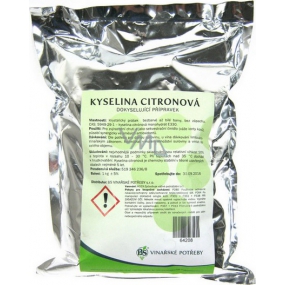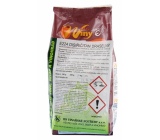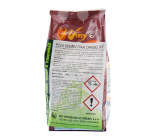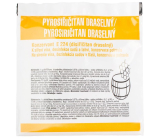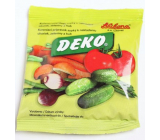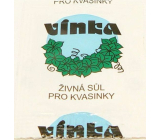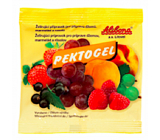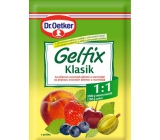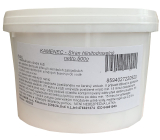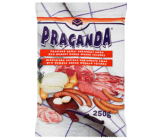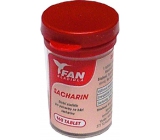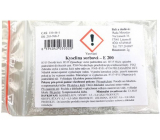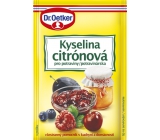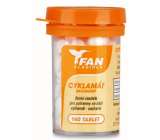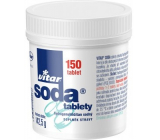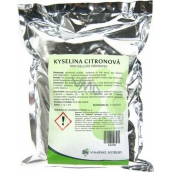- Washing
- Detergents
- Washing dishes
- Cleaning preparations
- Household appliances
- Rust and limescale
- Bathrooms and kitchens
- Universal cleaners
- Floors
- Toilet cleaner and disinfection
- Waste and septic tanks
- Windows and glass
- Furniture, dust
- Carpets and upholstery
- Cleaning wipes
- Electronics
- Garden furniture
- Gold, silver, metal
- Cleaning weapons
- Stone, tombstones
- Footwear and leather
- Sticker remover
- Cleaner of chimneys, fireplaces
- Asphalt spots
- Building material - disposal of algae, molds of mosses and bacteria
- Sprinkler defroster
- Disinfectant
- Air dehumidifiers
- Cleaning tools
- Ecological household
Citric acid acid for food, a proven household product 1 kg
| Code: | 80602 |
| EAN: | 64208 |
| Producer: | BS Vinařské potřeby s.r.o. |
| Brand: | Incanto n.c (web) |
 | |
| Nebezpečnost pro zdraví: | Nebezpečnost pro zdraví |
For flavour enhancement and as a sequestering agent (binds metal ions), it acts synergistically in antioxidant mixtures.
1. When preserving fruit and Vegetables.
2. For flavouring fruit salads, compotes and salad dressings.
3. To support the gelling process in the production of jams, marmalades and jellies.
4. For flavouring drinks.
5. For descaling, e.g. in coffee machines, etc.
Dissolve one teaspoon of Citric Acid in 1 litre of Water and immerse the peeled fruit to be preserved in this solution. In this way we can conveniently treat the fruit before subsequent preservation, e.g. by drying or heating.
DoSage
As required for the raw material, for wine the doSage is limited by the Wine Act. Whisk in a small amount of the raw material and stir in the entire volume.
Citric Acid can also be used for descaling, e.g. in kettles, coffee makers.
Descaling with Citric Acid
When hard Water is heated, Calcium compounds - limescale - are deposited on the heating elements of appliances. Calcium deposits are cheMically alkaline, so just use acid to remove the deposits. But in practice it is more complicated. We must use a product that is safe for health and will not damage the cleaned device, i.e. plastics, metals or seals. Food-grade Citric Acid fits the bill. It works just as reliably as vinegar, it is also non-toxic, but not as aggressive. Its dilution is about two teaspoons per half liter of Water. There can be no objection to its use, as it is also used in the descaling products sold.
Why descaling?
The first reason is to protect the appliance. Scale forms an insulating layer on the surface of the heating elements that does not allow proper heat transfer to the surrounding Water. This prolongs the time required to heat the Water and at the same time causes overheating of the heating element, which can lead to its destruction or the shutdown of its thermal protection in case of a thick layer of limescale. The second reason is to save electricity. As the scale layer increases the time required for heating, it also increases the electricity consumption. So by descaling, we also save energy. The third reason is that the taste is affected by the high Calcium content of the Water and its contamination by scaling particles, which is particularly evident in kettles. Some kettles even have microscreens in the mouth of the pouring spout to catch these particles. The fourth reason is hygiene. On the microscopically very rugged surface of the limescale, colonies of bacteria soon begin to flourish, which destroy the boil but often produce harmful substances. This is also the reason why it is recommended to boil one batch of Water first and pour it out after not using these appliances for a long time.
When to descale?
With kettles, it is easy to see Calcium deposits by looking inside. We can see the scale layer so we can easily keep an eye on it. If the scale layer is allowed to overgrow, a warning sign is an increase in heating time and a final warning if the kettle starts to shut off before the Water boils. This is particularly notICEAble for kettles with a concealed heating element. The coffee machine, espresso machine or washing machine does not provide any way to see limescale build-up, so it is advisable to descale regularly. How often descaling is necessary depends on the frequency of use and the hardness of the Water. It is roughly advisable to descale about once a month with frequent use. Also, with coffee and espresso machines, a warning should be the increase in the time it takes to make coffee. Gross neglect will then lead to a malfunction.
How to descale?
Generally, descaling is done by filling the heating coil with descaling solution, heating it and leaving it for 30 to 60 minutes. Descale the kettle by pouring the descaling solution into it and heating it. However, do not heat to the boiling point, but just until the Water is hot. Leave the solution for 30 to 60 minutes. Then pour out the solution and rinse the kettle. We also do not use the first Water heated to the boiling point. Fill the coffee machine reservoir with descaling solution and switch on the coffee machine. Let about half of the solution flow into the kettle and turn off the machine for 30 minutes. Then plug it back in and let the rest of the solution flow through. Fill the reservoir with clean Water and switch the machine back on. Pour the hot Water from the kettle. Simple espressos driven by steam pressure (you can recognize them by the pressure cap of the Water container) are filled with the solution, put on the coffee holder (without coffee) and let about half of the solution be pushed through it. Turn off the espresso and leave the solution for 30 minutes. Then plug back in and let the rest of the solution pass through. The next step is to rinse it with clean Water, but before that we have to let this type of espresso cool down so that we don't get scalded by the residual steam when we open the pressure cap of the Water container.
Espresso machines with a pressure pump (they have a Water tank without a pressure cap from which they draw Water) can only be descaled if this is stated in the instructions for use. Especially the more expensive models can be equipped with a decalcifier, which would be destroyed by conventional descaling. Models without a built-in decalcifier are decalcified in a similar way to single espressos.
Add 1 tablespoon (approx. 20 g) of Citric Acid to the washing machine for 1 wash cycle to prevent limescale build-up. For very hard Water, it's a good idea to pour one cup into the washing machine drum about once a month and let the washing cycle run on empty. There is no need to descale the washing machine when using phosphate-free detergents.
Characteristics
It is a weak acid from the carboxylic group. It occurs naturally in citrus fruits, especially Lemons, limes, grapefruit, Oranges and, to a lesser extent, other fruits and Vegetables.
Production
There are several methods of production. Citric Acid can be obtained naturally from citrus juice by fermenting raw sugar.However, common industrial production uses the fungal culture Aspergillus niger and Sucrose (mainly molasses, hydrolysed corn Starch or other cheaply obtained sugars). The addition of Calcium hydroxide (known as slaked lime) produces a salt from which sulphuric acid yields the final Citric Acid.Annual global production is estimated at 1.7 million tonnes, more than half of which is produced in China.
Storage
The most suitable storage conditions are relative humidity of 50% and temperature in the range of 10-30°C. At temperatures above 35°C, lumping occurs. Citric Acid is cheMically stable in tightly sealed containers for at least 5 years.
food grade Citric Acid
A colourless to white, odourless, crystalline powder. CAS: 5949-29-1 - Citric Acid Monohydrate E330.
Causes serious eye damage. Instructions for safe maintenance: wear protective gloves/protective clothing/protective goggles/face shield. Wash the skin thoroughly after handling. In case of eye contact: gently rinse with Water for several minutes. Remove contact lenses if they are in and if they can be removed easily. Continue rinsing. If eye irritation persists, seek medical attention/treatment. Place the packaging and unused product in marked hazardous waste collection containers.
Nebezpečnost pro zdraví
Nebezpečí
Může způsobit podráždění dýchacích cest. Může způsobit ospalost nebo závratě. Může vyvolat alergickou kožní reakci. Způsobuje vážné podráždění očí. Dráždí kůži. Zdraví škodlivý při požití. Zdraví škodlivý při styku s kůží. Zdraví škodlivý při vdechování. Rozkladem ozonu v horních vrstvách atmosféry poškozuje veřejné zdraví a životní prostředí.
Varování. Pokyny pro bezpečné zacházení
Zamezte vdechování prachu/dýmu/plynu/mlhy/par/aerosolů. Používejte pouze venku nebo v dobře větraných prostorách. Při vdechnutí: přeneste postiženého na čerstvý vzduch a ponechte jej v klidu v poloze usnadňující dýchání. Při požití: necítíte-li se dobře, volejte TOXIKOLOGICKÉ INFORMAČNÍ STŘEDISKO nebo lékaře. Používejte ochranné rukavice / ochranný oděv / ochranné brýle / obličejový štít. Při styku s kůží: omyjte velkým množstvím vody a mýdla. Při zasažení očí: několik minut opatrně vyplachujte vodou. Vyjměte kontaktní čočky, jsou-li nasazeny, a pokud je lze vyjmout snadno. Pokračujte ve vyplachování. Při používání tohoto výrobku nejezte, nepijte ani nekuřte. Uchovávejte mimo dosah dětí.
This item has not been discussed yet. If you want to be first, click on the button Add a contribution
For flavour enhancement and as a sequestering agent (binds metal ions), it acts synergistically in antioxidant mixtures.
1. When preserving fruit and Vegetables.
2. For flavouring fruit salads, compotes and salad dressings.
3. To support the gelling process in the production of jams, marmalades and jellies.
4. For flavouring drinks.
5. For descaling, e.g. in coffee machines, etc.
Dissolve one teaspoon of Citric Acid in 1 litre of Water and immerse the peeled fruit to be preserved in this solution. In this way we can conveniently treat the fruit before subsequent preservation, e.g. by drying or heating.
DoSage
As required for the raw material, for wine the doSage is limited by the Wine Act. Whisk in a small amount of the raw material and stir in the entire volume.
Citric Acid can also be used for descaling, e.g. in kettles, coffee makers.
Descaling with Citric Acid
When hard Water is heated, Calcium compounds - limescale - are deposited on the heating elements of appliances. Calcium deposits are cheMically alkaline, so just use acid to remove the deposits. But in practice it is more complicated. We must use a product that is safe for health and will not damage the cleaned device, i.e. plastics, metals or seals. Food-grade Citric Acid fits the bill. It works just as reliably as vinegar, it is also non-toxic, but not as aggressive. Its dilution is about two teaspoons per half liter of Water. There can be no objection to its use, as it is also used in the descaling products sold.
Why descaling?
The first reason is to protect the appliance. Scale forms an insulating layer on the surface of the heating elements that does not allow proper heat transfer to the surrounding Water. This prolongs the time required to heat the Water and at the same time causes overheating of the heating element, which can lead to its destruction or the shutdown of its thermal protection in case of a thick layer of limescale. The second reason is to save electricity. As the scale layer increases the time required for heating, it also increases the electricity consumption. So by descaling, we also save energy. The third reason is that the taste is affected by the high Calcium content of the Water and its contamination by scaling particles, which is particularly evident in kettles. Some kettles even have microscreens in the mouth of the pouring spout to catch these particles. The fourth reason is hygiene. On the microscopically very rugged surface of the limescale, colonies of bacteria soon begin to flourish, which destroy the boil but often produce harmful substances. This is also the reason why it is recommended to boil one batch of Water first and pour it out after not using these appliances for a long time.
When to descale?
With kettles, it is easy to see Calcium deposits by looking inside. We can see the scale layer so we can easily keep an eye on it. If the scale layer is allowed to overgrow, a warning sign is an increase in heating time and a final warning if the kettle starts to shut off before the Water boils. This is particularly notICEAble for kettles with a concealed heating element. The coffee machine, espresso machine or washing machine does not provide any way to see limescale build-up, so it is advisable to descale regularly. How often descaling is necessary depends on the frequency of use and the hardness of the Water. It is roughly advisable to descale about once a month with frequent use. Also, with coffee and espresso machines, a warning should be the increase in the time it takes to make coffee. Gross neglect will then lead to a malfunction.
How to descale?
Generally, descaling is done by filling the heating coil with descaling solution, heating it and leaving it for 30 to 60 minutes. Descale the kettle by pouring the descaling solution into it and heating it. However, do not heat to the boiling point, but just until the Water is hot. Leave the solution for 30 to 60 minutes. Then pour out the solution and rinse the kettle. We also do not use the first Water heated to the boiling point. Fill the coffee machine reservoir with descaling solution and switch on the coffee machine. Let about half of the solution flow into the kettle and turn off the machine for 30 minutes. Then plug it back in and let the rest of the solution flow through. Fill the reservoir with clean Water and switch the machine back on. Pour the hot Water from the kettle. Simple espressos driven by steam pressure (you can recognize them by the pressure cap of the Water container) are filled with the solution, put on the coffee holder (without coffee) and let about half of the solution be pushed through it. Turn off the espresso and leave the solution for 30 minutes. Then plug back in and let the rest of the solution pass through. The next step is to rinse it with clean Water, but before that we have to let this type of espresso cool down so that we don't get scalded by the residual steam when we open the pressure cap of the Water container.
Espresso machines with a pressure pump (they have a Water tank without a pressure cap from which they draw Water) can only be descaled if this is stated in the instructions for use. Especially the more expensive models can be equipped with a decalcifier, which would be destroyed by conventional descaling. Models without a built-in decalcifier are decalcified in a similar way to single espressos.
Add 1 tablespoon (approx. 20 g) of Citric Acid to the washing machine for 1 wash cycle to prevent limescale build-up. For very hard Water, it's a good idea to pour one cup into the washing machine drum about once a month and let the washing cycle run on empty. There is no need to descale the washing machine when using phosphate-free detergents.
Characteristics
It is a weak acid from the carboxylic group. It occurs naturally in citrus fruits, especially Lemons, limes, grapefruit, Oranges and, to a lesser extent, other fruits and Vegetables.
Production
There are several methods of production. Citric Acid can be obtained naturally from citrus juice by fermenting raw sugar.However, common industrial production uses the fungal culture Aspergillus niger and Sucrose (mainly molasses, hydrolysed corn Starch or other cheaply obtained sugars). The addition of Calcium hydroxide (known as slaked lime) produces a salt from which sulphuric acid yields the final Citric Acid.Annual global production is estimated at 1.7 million tonnes, more than half of which is produced in China.
Storage
The most suitable storage conditions are relative humidity of 50% and temperature in the range of 10-30°C. At temperatures above 35°C, lumping occurs. Citric Acid is cheMically stable in tightly sealed containers for at least 5 years.
food grade Citric Acid
A colourless to white, odourless, crystalline powder. CAS: 5949-29-1 - Citric Acid Monohydrate E330.
Causes serious eye damage. Instructions for safe maintenance: wear protective gloves/protective clothing/protective goggles/face shield. Wash the skin thoroughly after handling. In case of eye contact: gently rinse with Water for several minutes. Remove contact lenses if they are in and if they can be removed easily. Continue rinsing. If eye irritation persists, seek medical attention/treatment. Place the packaging and unused product in marked hazardous waste collection containers.
Nebezpečnost pro zdraví
Nebezpečí
Může způsobit podráždění dýchacích cest. Může způsobit ospalost nebo závratě. Může vyvolat alergickou kožní reakci. Způsobuje vážné podráždění očí. Dráždí kůži. Zdraví škodlivý při požití. Zdraví škodlivý při styku s kůží. Zdraví škodlivý při vdechování. Rozkladem ozonu v horních vrstvách atmosféry poškozuje veřejné zdraví a životní prostředí.
Varování. Pokyny pro bezpečné zacházení
Zamezte vdechování prachu/dýmu/plynu/mlhy/par/aerosolů. Používejte pouze venku nebo v dobře větraných prostorách. Při vdechnutí: přeneste postiženého na čerstvý vzduch a ponechte jej v klidu v poloze usnadňující dýchání. Při požití: necítíte-li se dobře, volejte TOXIKOLOGICKÉ INFORMAČNÍ STŘEDISKO nebo lékaře. Používejte ochranné rukavice / ochranný oděv / ochranné brýle / obličejový štít. Při styku s kůží: omyjte velkým množstvím vody a mýdla. Při zasažení očí: několik minut opatrně vyplachujte vodou. Vyjměte kontaktní čočky, jsou-li nasazeny, a pokud je lze vyjmout snadno. Pokračujte ve vyplachování. Při používání tohoto výrobku nejezte, nepijte ani nekuřte. Uchovávejte mimo dosah dětí.
